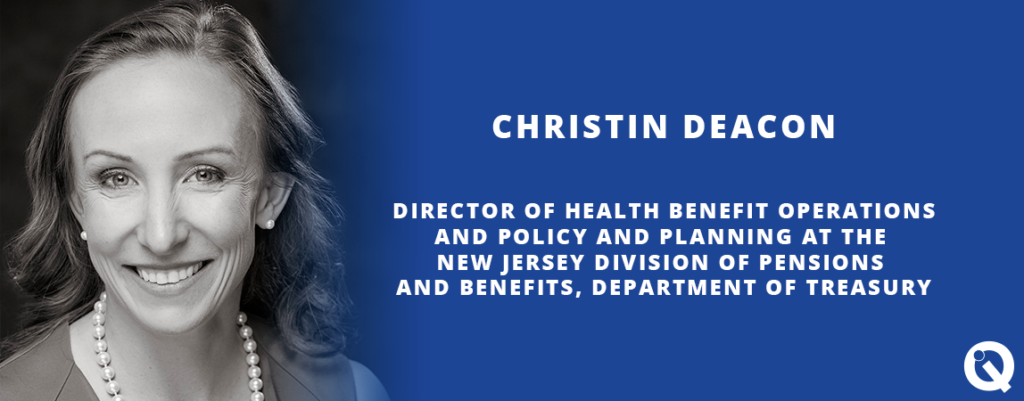Christin Deacon is Director of Health Benefit Operations and Policy and Planning at the New Jersey Division of Pensions and Benefits, Department of Treasury.
First, can you tell us about your role in the state’s Division of Pensions and Benefits?
As an Assistant Director, I lead the Health Benefits section, which consists of two divisions. There’s the Policy and Planning team, which is a team of data scientists and strategic thinkers, population health experts — we’re building that team out currently. And then there’s the Operations team, which handles enrollments, local government, school districts, reporting and all of the operations side. Currently we have about 30 employees across those teams.
The State and School Health Benefits Plan (SHBP/SEHBP) just awarded a new contract to serve state, local, and education employees. Can you tell us about any important changes and why you sought to implement these changes?
The new agreement encompasses a number of new approaches both to improve healthcare outcomes and quality — as well as cost containment. Most notably, we’re the largest public sector employer to date to engage navigation and advocacy services for our members across the entire population, and that’s certainly a new component of the contract.
These services will provide a concierge level of navigation services to our members, on everything from dealing with claims and billing questions to the use of complex predictive analytics to identify gaps in care for our members —and help to close those gaps.
The other innovative piece to the new contract is the cost containment and accountability measures that we’ve built into it. So rather than looking solely at that elusive “discount” off charges, we’re actually able to extract unit cost guarantees. That’s meant to protect the State from the impact of medical inflation and certain utilization trends. As you know, hospitals control charges. And so the more they charge, the better the discount might look. But, by looking to unit cost guarantees, we’re really able to extract more value.
How closely does Treasury work with the other agencies that purchase health care or fund health care providers, such as the state Medicaid program or the Department of Corrections?
I would say unfortunately at this time our program does not work as closely with those other agencies as we should to leverage our spending power. That being said, we are making a really big push to become more collaborative with other agencies such as the Department of Health, Medicaid, Corrections, and NJ Transit and are exploring ways that we can leverage our buying power as a group. We see a real opportunity to leverage our size and spend to extract more value for the State and taxpayers.
Data obtained through the Health Care Cost Institute found that employer-sponsored insurance spending in New Jersey has gone up 22.3 percent in the past five years. Are there steps you are taking to control these steep increases in health care costs?
I would say that one of the fundamental shifts that I’m trying to implement, both with my staff as well as with our vendors, is a change to a more consumer-driven culture of health care. That’s sending our members to high quality providers and being transparent about the total costs, not just the consumer’s out-of-pocket costs, but what the state is paying as well. Because at the end of the day it’s taxpayer money.
We’re in a unique position with the SHBP and the SEHBP because of our members’ relatively low-cost share, when compared to our public sector peers and the private market. In some ways, they’re shielded from the entirety of that 22.3% trend. This dynamic puts us in a unique position to leverage our size and spend in order to extract as much value out of our health care dollars as possible – because we must. I mean, we’re reaching a point whereas a society — and certainly as a state — status quo healthcare spend and trend is just not sustainable.
The Treasurer and SHBP/SEHBP Leadership recently joined the Quality Institute’s Leadership Council. How do you envision the relationship working — and how will being part of the Quality Institute support your work?
It is my honest opinion that we can leverage our size and spend to really turn the needle on healthcare in New Jersey. Whether that’s through transparency initiatives, quality initiatives, reference-based pricing, centers of excellence and more. I think we can benefit from the Quality Institute’s true sense of the pulse of the New Jersey’s healthcare landscape. So, from your Mayors Wellness Campaign, or Conversation of Your Life initiatives, to your Medicaid work on prenatal and perinatal health. And so, I think the real opportunity lies in bringing what we must bear in terms of leverage due to our size; and the Quality Institute’s localized perspective. Marrying those two things together can really add value — not just to our membership but also across the state for all citizens.

